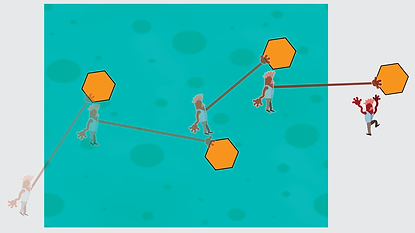Professor Stretch is a lighthearted game about a teacher rounding up his scattered students during a field trip to an unexplored planet. Players use Professor Stretch’s stretchy arm to swing and fling around a colorful alien environment filled with glyx, a strange gelatinous substance with different forms that can slow the professor or speed him up! The player is tasked with exploring this wacky world to collect students and glyx samples, all while swinging around and maintaining a feeling of flow.
Overview
Professor Stretch
Game Genre: Platformer
Development Span: Four months
Personal Role: Systems Designer
Platform: PC
As Professor Stretch, players use their stretchy arm to grab onto platforms and swing or fling themselves through the environment. This is the player’s method of navigating through the levels, and is the single most important mechanic of the game.
I joined the team for Professor Stretch just after preproduction. At this time, the team had a working prototype of the game, and a general vision of how it would progress in the future. While the swinging mechanic was still fun at this stage, QA testers noted that they didn't feel like they were in control while swinging, but couldn't necessarily describe why. As a systems designer, I sought to improve upon the swing mechanic while still maintaining the vision established by the lead designer.
The Stretchy Arm


I started this process with thorough experimentation, ensuring that I fully understood the system as it was currently implemented. I was able to determine that the reason for the lack of control stemmed from the elasticity of the stretchy arm interfering with vertical movement. This became extremely troublesome when a player ran out of momentum, often times meaning there was nothing they could really do except detach and completely reset their positioning, greatly disturbing the flow of the game.

I outlined the new specifications of the swing mechanic in a visual design document, and worked closely with our lead programmer to get it implemented. Together we crafted a new version of the system that took better advantage of the fun bungee aspect of the stretchy arm, while allowing for smoother horizontal and vertical arcs. Once the groundwork was set by the programmer, I was able to continue tweaking the values based on QA feedback until nearly all testers were satisfied with the mechanic. This improved system gives the player a lot more control, and ultimately allows for gameplay with a much better feeling of flow.

Identified Issue
My Solution
As one of only three designers on the team, I remained flexible enough to bounce around to many different tasks and feature teams, working with other designers, programmers, and artists. I was involved with, and had influence over level challenges and structure, glyx functions, animation/particle feedback, GUI elements, and more. I also assisted in running QA, and personally observed tester play-sessions while collecting feedback, then creating QA analysis documents to share with the rest of the team.
Other Responsibilities
Designers: Carlos Gutierrez, Cody Winchester
Programmers: Eric Pacelli, Chris McCooey, JoyLee Flahive
Artists: Luke Douglas, Jesse Miles, Adam Zemany, Shaun Davies
Producer: Will Harrison
Team Members
Glyx

Glyx is a gelatinous substance that is scattered throughout the world of the game. Depending on its color, passing through glyx will either slow down (blue glyx) or speed up (green glyx) the player, creating interesting challenges for the player to overcome.
I suggested that instead of being solid objects, glyx should be gelatinous volumes that the player can pass through while swinging. Instead of brittle glyx acting as a solid barrier, slow glyx would act as a permeable barrier that allows players to use the stretchy arm in a new way by pulling themselves through the glyx. Rather than have bouncy glyx as a ground-based “motion enhancer,” speedy glyx would accelerate the player without them ever having to leave the air. Our team’s lead designer and I would later build upon these concepts into the fun and engaging version of glyx that we have now.


Identified Issue
The preproduction version of glyx was overly complicated and confusing, and wasn’t cohesive to the swing mechanic. It featured brittle glyx that could be broken with the stretchy arm, bouncy glyx that would bounce the player on contact, and harmful glyx that would damage the player (when we used to have a health system).
Shortly after joining the team, we had a brainstorming session on how to improve upon glyx. I noted that glyx felt disconnected from the swinging aspect of the game, as each type of glyx interrupted swinging in some way, rather than accentuating on the feeling of flow that the game was going for.
My Solution
Slow glyx suspends the character within it, requiring the player to grab objects to pull themselves through.
Speedy glyx accelerates the character, propelling him forward along the vector he had when entering it.
